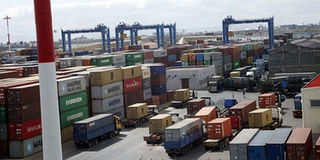Breaking: Autopsy reveals how Cyrus Jirongo died
Premium
Officials try to save face after ‘Nation’ expose on SGR deal

The inland container depot in Embakasi, Nairobi. The depot is managed by the Kenya Ports Authority. PHOTO | FILE | NATION MEDIA GROUP
What you need to know:
- The loan contract Nairobi entered into with Beijing has several clauses that heavily favour China and compel Kenya to make many compromises.
- KPA faces a particularly huge takeover risk as the Chinese loan negotiators ensured it was included in a strict take-or-pay agreement with Kenya Railways Corporation.
Government officials involved in the construction and running of the standard gauge railway (SGR) were last evening scrambling to save face in the wake of a Nation exposé that detailed the financial traps of Chinese loan pacts with Kenya.
Sources told the Nation that senior officials met on Sunday to deliberate on the matter.
More meetings are scheduled starting today to discuss the leaking of details of the loan Kenya signed with the Exim Bank of China in 2014, in which, it has emerged, the country waived sovereignty on all its assets in case Nairobi defaults on loan repayments.
In a bid to calm nerves, Kenya Railways Corporation last evening cancelled a media tour planned for this morning to give a progress update on the construction of the second phase of the SGR.
It did not give any reason for the sudden change of plan, only promising that “a new date will be communicated” soon.
ASSETS
The loan contract Nairobi entered into with Beijing has several clauses that heavily favour China and compel Kenya to make many compromises, with the most controversial one being the waiver of sovereignty on assets.
Sovereign lending deals do not usually include the offering of collateral by the borrower, which explains why China’s angling for Kenyan national assets has puzzled many within and outside government.
State officials on Sunday remained tight-lipped on the matter, while economic analysts, while agreeing that Kenya seemed to have mortgaged itself while negotiating the huge loan, were careful not to be referenced directly.
“It is weird and I really don’t know what the Chinese could be up to, given that it is not even practical to attach national assets as a loan collateral,” a Nairobi-based economic analyst told the Nation.
“Sovereign guarantees are usually sufficient to cover for loans borrowed by governments.”
PARASTATALS
The revelations have now turned the nation’s collective attention to the various multibillion-shilling deals Kenya has signed with government enterprises in China, including major infrastructure deals in the energy and transport sectors.
Because of the collateral clauses, Kenya’s cash-rich parastatals and firms risk Chinese takeover in case of a default.
Among them is the Mombasa-headquartered Kenya Ports Authority, whose exposure risk was recently the subject of an audit query by the Auditor-General.
KPA faces a particularly huge takeover risk as the Chinese loan negotiators ensured it was included in a strict take-or-pay agreement with Kenya Railways Corporation, meaning the port is at the centre of Kenya’s repayment obligations.
Other than its strategic importance to the SGR cargo operations, the port of Mombasa, the busiest in East Africa, is also quite lucrative, with annual revenues dancing around the Sh50 billion mark.
PORTS
It is the perfect gateway to a region in which China now commands a huge share of the market, with the value of imports to Kenya alone — mainly machinery and transport equipment — hitting Sh292 billion in the first 10 months of 2018.
KPA is not only responsible for the running of the port of Mombasa, but is also in charge of the development, maintenance, operation, improvement and regulation of the sea ports of Funzi, Kilifi, Kiunga, Lamu, Malindi, Mtwapa, Shimoni and Vanga on the coast of Kenya.
It also manages three inland container depots in Nairobi, Kisumu and Eldoret, and has three liaison offices in Kampala, Kigali and Bujumbura to cater for transit countries.
Another dry port is expected to be constructed in Naivasha, and plans are underway to put up a Sh14 billion port in Kisumu.
The only other State-owned firms with similar strategic importance are Kenya Electricity Generating Company (KenGen), Kenya Power and Kenya Pipeline.
REVENUE
Part of the reason China wanted a strategic asset to cover its back was the fear that the SGR would not support itself.
In July 2018, Transport Cabinet Secretary James Macharia told a parliamentary committee that the SGR operator had made a loss of Sh110 billion in its first year of operations.
“On average, the line made a monthly loss of $7.5 million in the 2017/2018 financial year, largely as a result of low cargo business,” Mr Macharia said.
“However, we now project that it will turn around and make a profit of $50 million by June next year, averaging $4.2 million profit monthly as we ramp up cargo volumes.”
The plan relies on the rather optimistic estimate that the train’s daily tonnage run will go above 800 containers, out of the 1,700 that arrive at the port.
A new transport tariff will increase charges by nearly 80 percent and could prove counter-productive and create more competition from truckers, who also have the last-mile advantage.





